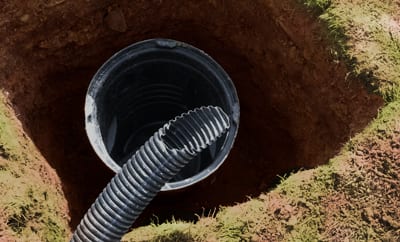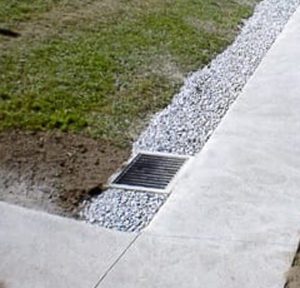Downspout Extensions & Leadoffs
It’s all about drainage. Take a look at your gutters and downspouts. Do your downspouts end right at the base of your foundation? When it rains, does the water soak into the soil next to your house?
That causes more problems than you may realize. Water is absorbed into the soil, causing the earth next to your home to expand, exerting pressure against the foundation. Over the course of a season, the water builds up. When winter comes, it freezes and expands as ice.
These forces are tremendous and overtime they crack and bow your basement walls. Your basement floods.
The simple answer is, direct the water away from your foundation.
 Inspect Your Gutters
Inspect Your Gutters
Before anything else is done, you need to inspect and clean your gutters. When your gutters are clogged with leaves or blocked by that rubber ball your kids lost throwing it on the roof, water cascades straight down to your foundation. Making sure your gutters and downspouts are operating properly is the first step.
Extend Your Downspouts
Downspout extensions are the next best step. Add some length to the downspout to move that water away from the soil next to the foundation.
Call in the Professionals at D-Bug to Help
At D-Bug Waterproofing, we are your yard drainage experts. We’ve been helping your neighbors with basement waterproofing issues for decades. We’re experts at directing water away from your home before it can cause problems, like leaks, cracks, and basement flooding.
Our landscaping experts can improve the grading and slope of the land around your home, fill in low spots that collect water, and install downspout leadoffs, exterior French drains, and home catch basins and storm drains.
Downspout Leadoffs from D-Bug Waterproofing
 We install downspout leadoffs using a 3 to 4 inch pipe that runs underground from the downspout on the house. This drains rain water away from your home.
We install downspout leadoffs using a 3 to 4 inch pipe that runs underground from the downspout on the house. This drains rain water away from your home.
We dig a shallow ditch 6 to 24 inches deep, depending on the terrain. D-Bug grades the slope of the surface to help with the drainage. In some situations, we install a gravel pit sump well.
Sump wells are needed due to grading issues or by code enforcement in certain townships.
A sump well is a hole that is dug about 3 to 4 feet deep and 3 to 4 feet across. We either install a sump pit or a 12 to 24 inch pipe with holes. The function of the holes is to let the water drain or seep into the ground.
Next, the hole around the pit is filled with gravel. A layer of fabric is placed over the gravel, followed by 4 to 10 inches of dirt used for planting grass. Certain townships require sump pumps to drain into sump wells, while other townships require both the downspouts and sump pumps to drain into the sump wells.
In all cases, D-Bug would follow the Code as required by your local township.

The purpose of downspout and drainage-related codes is to make sure that water doesn’t end up in someone else’s property. Land around a home should be graded in such a way that water flows away from the home, but not at the expense of your neighbors. D-Bug Waterproofing re-grades yards to slope the terrain away from the house or structure.
Regrading the yard keeps the water from running against the house and directs it to a specific area. In some situations, dirt is added against the house, yet some yards may require removing dirt.
All too often, downspouts arbitrarily direct water straight down into the ground. D-Bug makes sure that water is drained away from your house and into the proper places, such as a dry well or storm sewer.
